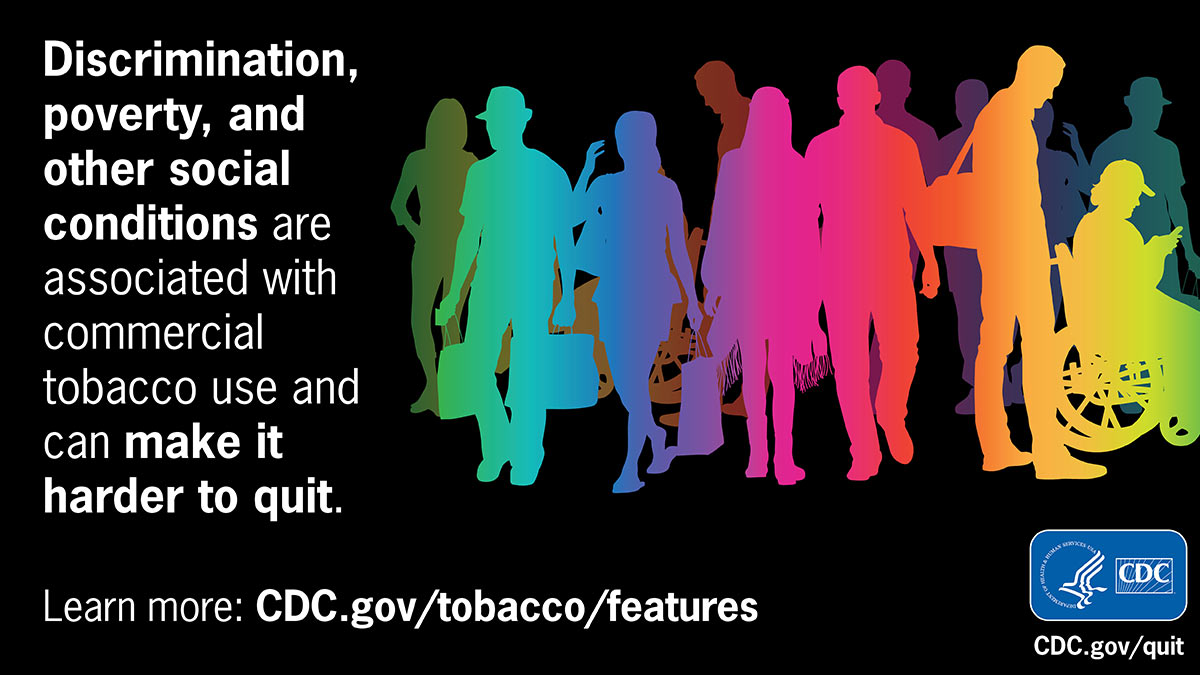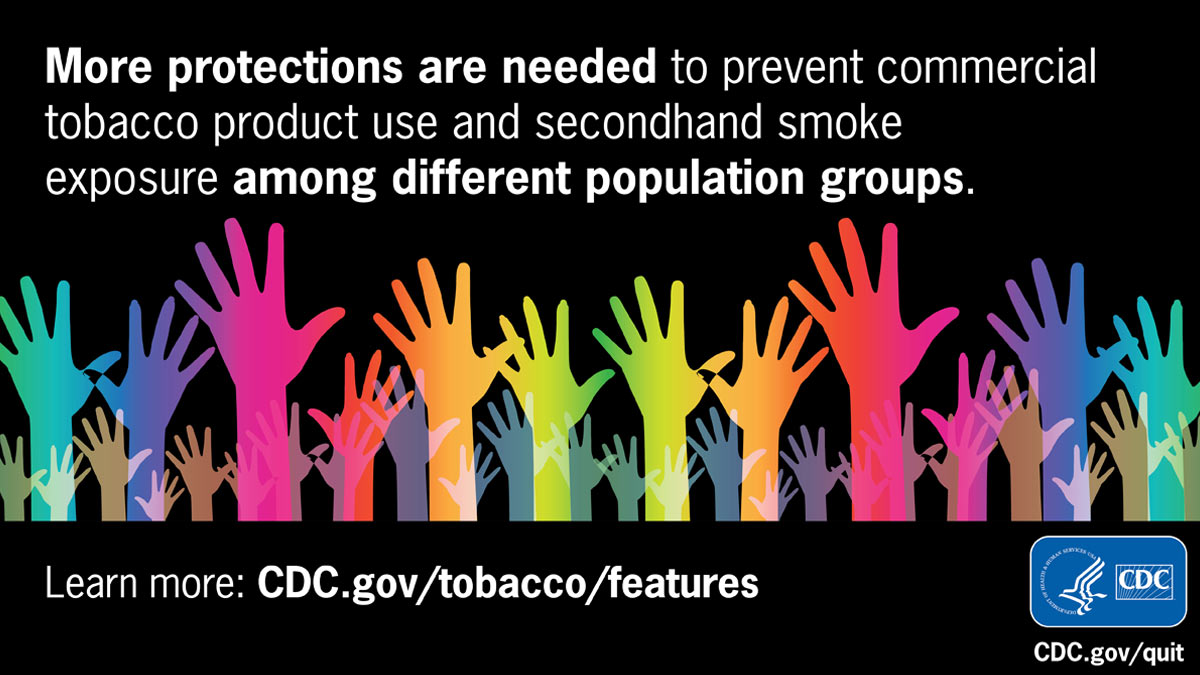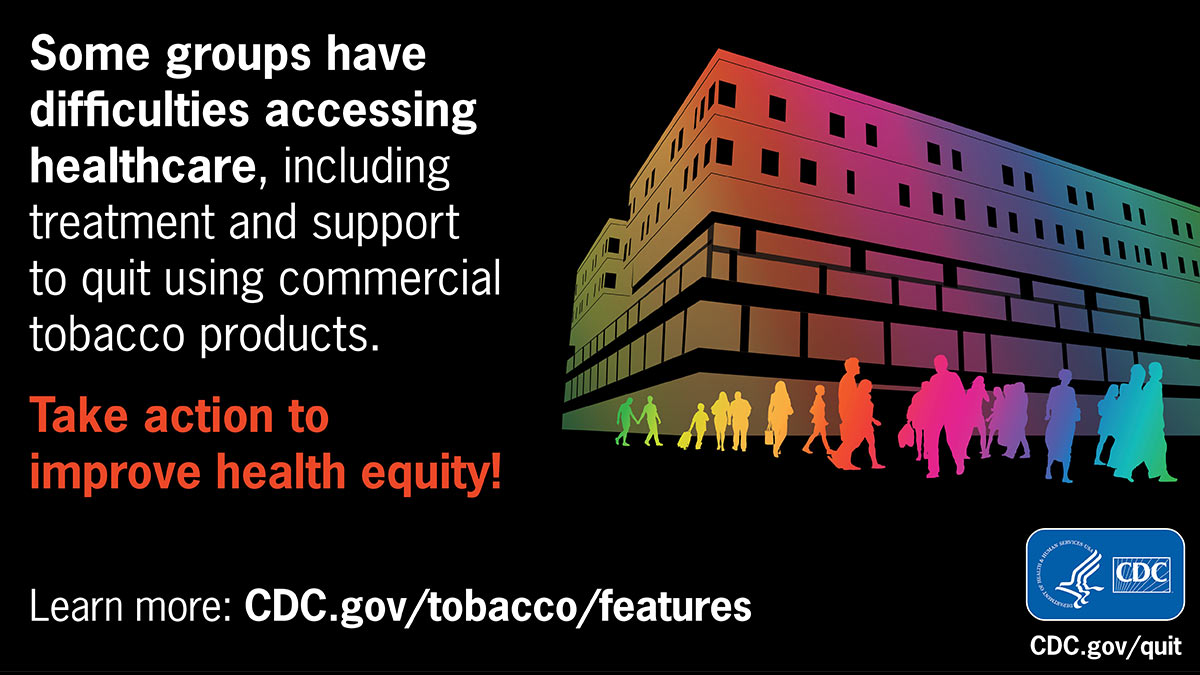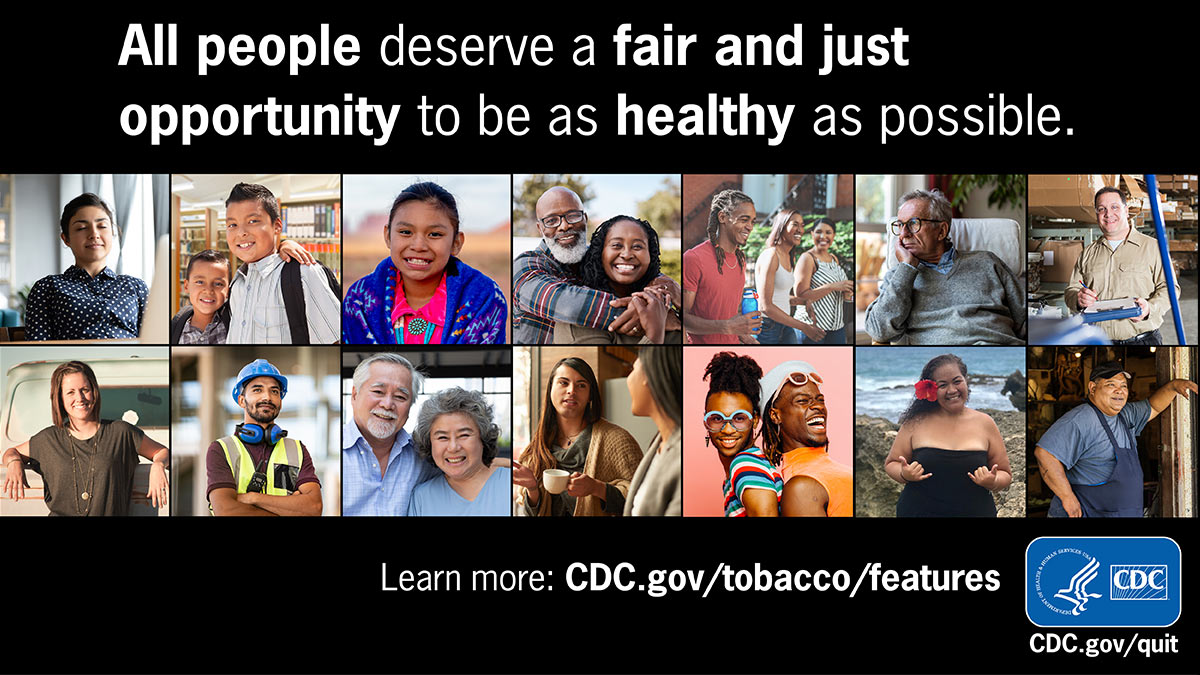What to know
Health equity is the fair and just opportunity for all individuals to attain their highest level of health, including addressing disparities caused by commercial tobacco.

What is health equity?
Health equity is the fair and just opportunity for all people to be as healthy as possible, and that includes the opportunity to be free from commercial tobacco. Yet, some people don’t have this opportunity because of factors like their race or ethnicity, where they live, or what kind of job they have.
For decades, tobacco companies have used promotions, targeted marketing, and other tactics to unfairly increase access to and appeal of tobacco products for certain population groups. Discrimination, poverty, and other social conditions have also been linked to tobacco product use and can make it harder to quit. These factors are linked to high levels of disease, disability, and death from tobacco use in some populations—like Hispanic and Latino people and people with behavioral health conditions.
More protections are needed to prevent tobacco product use and secondhand smoke exposure among different population groups, and to help people who use tobacco to quit for good. Everyone deserves to be as healthy as they can be, and that means living free from the harmful effects of commercial tobacco. By increasing efforts in these areas, we can advance health equity.
Social determinants of health and their relationship to health behaviors
Social determinants of health are conditions in the places where people live, learn, work, and play that affect health and quality of life. Examples of social determinants of health related to tobacco include retail conditions like the number of stores that sell tobacco in a neighborhood. It also includes where in stores tobacco products are displayed and advertised.
Education, job opportunities, and income are other social determinants of health that can influence how healthy a person can be. For example, lower quality education can be associated with less ability to understand and act on health information and less access to good jobs with health insurance. People with lower incomes can have less access to healthcare, including care needed for smoking-related health conditions.
Some social determinants of health can lead to stress, which can also affect people's tobacco product use. Stress from financial problems, discrimination, or unsafe neighborhoods can make it harder to quit smoking and can even increase tobacco product use. When people have severe or long-lasting forms of stress, their bodies can respond by raising stress hormones and keeping them raised. If this goes on for a long time, they may develop health problems such as high blood pressure or type 2 diabetes.

Targeted marketing of commercial tobacco products
Tobacco companies spend billions of dollars each year to market their products. They continue to target specific population groups, including youth and people who are African American, Hispanic, American Indian and Alaska Native, Asian, LGBTQ+, and people who live in low-income communities. Tobacco companies target specific groups by promoting and advertising products in areas where these groups live, shop, and attend events.
Targeted marketing can include:
- Donations, scholarships, and giveaways.
- Nightlife marketing—like in bars, clubs, and nightclub after-parties.
- Price promotions such as discounts, coupons, and special sales.
- Product placement.
- More tobacco retailers in racial and ethnic communities and neighborhoods with lower income.
- Sponsorships of sporting events, parades, and cultural events.
Tobacco product marketing can make smoking seem more appealing. It can also increase the chance that someone will try it for the first time or start using tobacco products regularly.
Actions to improve tobacco-related health inequities
States and communities can take action to make tobacco products less appealing and less available. For example, they can increase prices and prohibit price discounts, prohibit the sale of flavored tobacco products, allow fewer stores in a neighborhood to sell commercial tobacco products, or prohibit tobacco product sales altogether.
States and communities also can create stronger smokefree air policies that protect all people from secondhand smoke. In states that do not have statewide smokefree policies that ensure all public places and workplaces are smokefree, some communities have passed smokefree air laws that apply to these spaces. These policies are important because they protect people who don’t smoke from secondhand smoke, motivate those who smoke to quit, and prevent people from starting to smoke. Right now, not everyone is equally protected from the dangers of secondhand smoke.
States and communities can protect all people from tobacco product marketing and discourage tobacco product use by doing the following:
- Adopt commercial tobacco use policies for public places and make sure people who want to quit can get the help they need.
- Make all workplaces smokefree—with no exceptions.
- Educate people about the dangers of exposure to secondhand smoke.
- Encourage people to set rules that prohibit smoking in their apartments, single-family homes, and vehicles.
- Keep the prices of tobacco products high.
- Reduce or eliminate the sale of tobacco products.

Access to quit-smoking treatment
Proven treatments, such as FDA-approved medicines and behavioral counseling, can help people successfully quit smoking. But some people face barriers to these treatments because of where they live, their employment status, or their health insurance coverage. Other barriers can be related to someone's race or culture. For example, studies have consistently shown that members of some racial or ethnic groups receive less counseling from their doctors and have poorer outcomes than White patients with the same ailments.
States, communities, and health care systems can help improve access to treatments by doing the following:
- Ensure that barrier-free health insurance coverage for evidence-based quit-smoking treatments, like FDA approved medications and behavioral counseling, are available and widely promoted.
- Integrate clinical screening and treatment for commercial tobacco use in all healthcare settings and with all types of patients.
- Increase access to quit-smoking services that are acceptable to different cultures and communicated in different languages.
- Share health messages that reach specific groups experiencing health disparities.
- Ensure people can easily get the help and support they need to quit smoking.

Better health for all
A commitment to health equity involves understanding the causes of tobacco-related health disparities. By addressing social determinants of health, including those related to targeted marketing and barriers to healthcare, states and communities can move toward health equity and reduce health disparities.

*"Commercial tobacco" means harmful products that are made and sold by tobacco companies. It does not include "traditional tobacco" used by Indigenous groups for religious or ceremonial purposes.
